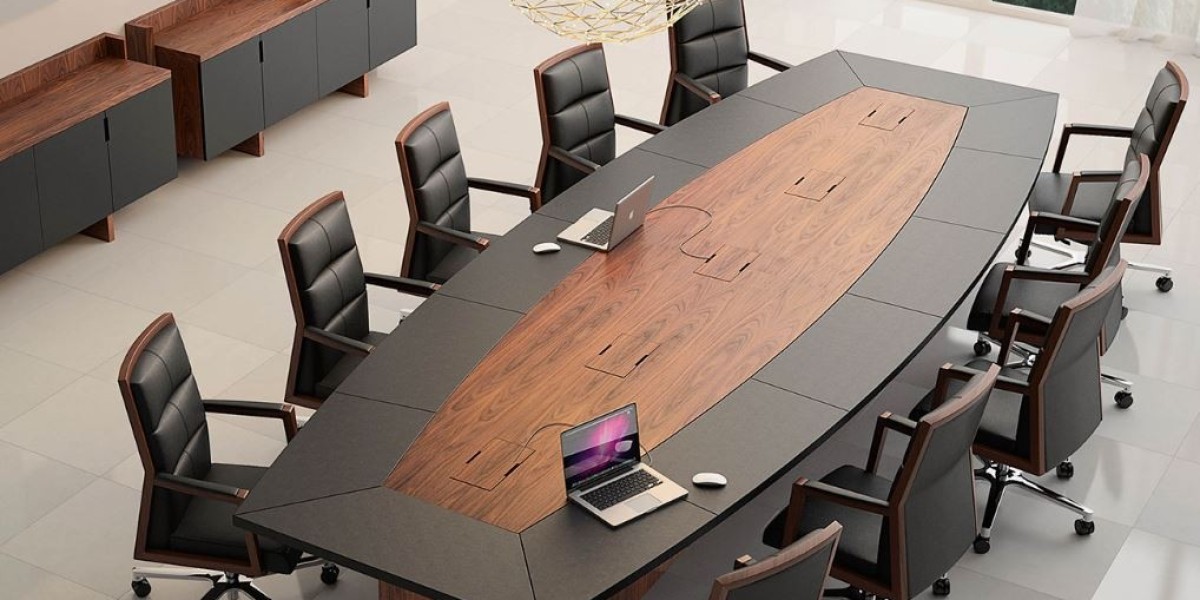In any modern business environment, the conference table is more than just a piece of furniture—it is the focal point for collaboration, brainstorming, and strategic planning. As organizations continue to redesign their workspaces to encourage more efficient communication and team engagement, the importance of choosing the right conference table dimensions cannot be overstated. The size of the table directly influences how many people can be accommodated comfortably, how the room flows, and how technology integrates into meetings. Whether you are designing a compact boardroom or a spacious executive meeting area, understanding standard and custom table dimensions is critical to maximizing functionality and comfort.
Why Getting the Right Conference Table Dimensions Matters
The physical dimensions of a conference table can affect more than just aesthetics. Properly sized conference tables help promote ergonomic seating arrangements, prevent overcrowding, and ensure that every participant has adequate workspace. If the table is too large for the room, it may obstruct movement and make the space feel cramped. On the other hand, if the table is too small, it could leave attendees feeling cramped or excluded. Meeting rooms should be designed to foster effective communication, and this starts with selecting the right table size. Not only does this show professionalism, but it also ensures that presentations, discussions, and collaborations can proceed smoothly.
Standard Conference Table Dimensions and Seating Capacity
When considering conference table dimensions, there are general standards that businesses often follow to make seating and spacing more predictable. A typical rectangular conference table measures around 96 inches (8 feet) in length and 48 inches in width, which can accommodate around 8 to 10 people comfortably. For larger meetings involving 12 to 14 participants, tables may stretch up to 144 inches (12 feet) or more. Circular tables, commonly used in smaller rooms or for more intimate meetings, usually range from 36 to 72 inches in diameter. Each attendee typically requires about 30 inches of table edge space to sit and work without discomfort. Keeping these dimensions in mind can help prevent bottlenecks and ensure everyone has enough room to participate actively.
Room Size and Layout Considerations
One of the first steps in choosing the correct conference table size is evaluating the dimensions of your meeting room. To allow for smooth movement around the table and chairs, there should be at least 36 to 48 inches of clearance between the edge of the table and the walls or other furniture. This spacing allows people to enter and exit their seats without disrupting others. Additionally, consider where doors, electrical outlets, windows, and presentation screens are located. These elements influence where the table can be positioned and how much flexibility you have in your layout. If you plan to incorporate AV equipment or video conferencing tools, make sure the table dimensions support cable management and power access without creating clutter.
Different Shapes and Their Functional Implications
Conference tables come in a variety of shapes, each offering unique benefits depending on the room type and intended use. Rectangular tables are the most traditional and offer the highest seating capacity for their size. Boat-shaped tables—wider in the middle and narrower at the ends—improve sightlines, making them ideal for presentations. Round or oval conference tables encourage equality and group participation, often used in creative or team-building meetings. Modular or reconfigurable tables offer flexibility, allowing businesses to adjust conference table dimensions depending on the number of attendees or type of meeting. Your choice of shape should align with how your team collaborates and the nature of the work being done in the space.
Material and Design Factors That Influence Dimensions
Materials also play a crucial role in determining the overall weight and structure of a conference table. Solid wood tables, while luxurious and sturdy, are typically heavier and may require more robust leg support, affecting legroom. On the other hand, laminate or glass-top conference tables may offer slimmer profiles, making them more space-efficient. Design details such as built-in cable management ports, wireless charging zones, or AV integrations can also impact the usable surface area. These features, while enhancing functionality, slightly reduce the effective workspace per person. When calculating your ideal conference table dimensions, it's essential to account for these design elements that could influence user experience and layout flexibility.
Tailoring Conference Table Dimensions to Team Needs
Every business has unique needs when it comes to meeting space. A startup may only require a compact table for 4 to 6 people, while a corporate head office might need a 20-foot custom-built table for board meetings. Some teams prioritize face-to-face collaboration, while others require space for laptops, projectors, or document reviews. The dimensions you choose should reflect your team's daily activities. In hybrid or remote-friendly workplaces, conference rooms may also serve as hubs for virtual collaboration, necessitating the inclusion of high-definition displays and microphones. In such cases, ensuring the table does not obstruct camera angles or sound transmission becomes a key consideration. Custom-built conference tables can provide the flexibility to align with your workflow and physical space simultaneously.
Tips for Measuring and Planning Conference Table Dimensions
Before purchasing or designing a conference table, it's essential to measure your room thoroughly. Use a scaled floor plan to visualize how different conference table dimensions will fit. Account for chair movement, walking space, and accessibility. When in doubt, go for modular table systems that can be extended or retracted based on requirements. Include the dimensions of additional furniture like credenzas, whiteboards, or presentation stands to ensure the room remains functional and not overly crowded. Consult with furniture experts or space planners who can recommend the best options based on room size, number of users, and intended usage. A well-planned meeting room setup leads to more productive discussions and a better overall workflow.
Conclusion: Invest Wisely in Your Meeting Room Setup
Choosing the right conference table dimensions plays a vital role in building a professional and efficient meeting environment. It impacts how your team interacts, how clients perceive your space, and how adaptable your workspace is to evolving business needs. Whether you’re opting for a standard size or a custom solution, remember to prioritize comfort, flexibility, and space optimization. A well-sized conference table enhances productivity, encourages engagement, and supports long-term business growth. For high-quality, customizable, and ergonomically designed conference tables, the office furniture supplier Philippines offers a wide selection that caters to all workspace needs. Investing in the right table today means setting your team up for success tomorrow.








